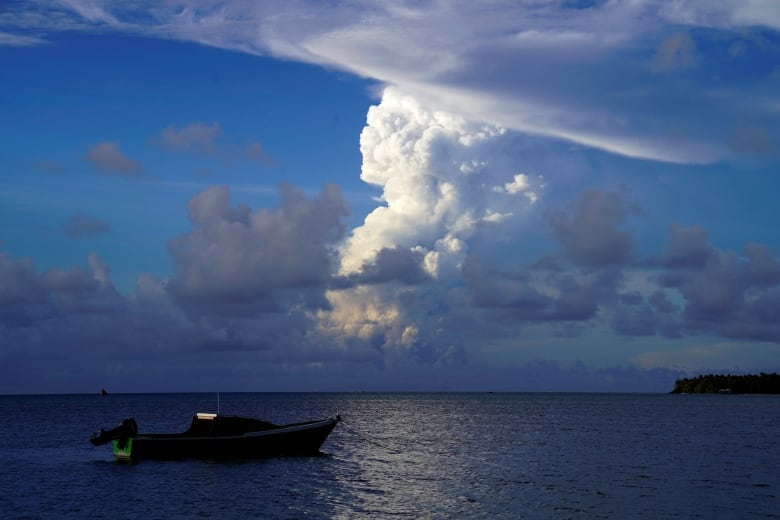An undersea volcano erupted in spectacular fashion near the Pacific nation of Tonga on Saturday, sending tsunami waves crashing across the shore and people rushing to higher ground.
There were no immediate reports of injuries or the extent of the damage as communications with the small nation remained problematic. Video posted to social media showed large waves washing ashore in coastal areas of Tonga, swirling around homes and buildings.
New Zealand's military said it was monitoring the situation and remained on standby, ready to assist if asked.
In Canada, a tsunami advisory was issued for parts of the B.C. coast — specifically the north coast and Haida Gwaii, the central coast and northeast Vancouver Island, the outer west coast of Vancouver Island and the Juan de Fuca Strait coast.
Officials in Saanich, on Vancouver island, said there is no need to evacuate — that the potential risk is limited to increased tidal currents — but they urged people to avoid beaches and marinas.
A tsunami advisory has been issued for our area. This is an advisory ONLY. There is NO need to evacuate, the potential risk is limited to increased tidal currents and therefore UNTIL the advisory is rescinded, please avoid beaches and marinas. <br>FYI <a href="https://twitter.com/hashtag/CSaan?src=hash&ref_src=twsrc%5Etfw">#CSaan</a> is in Zone D & E <a href="https://t.co/TNR3Trgkuv">https://t.co/TNR3Trgkuv</a>
—@CSaanich
A tsunami advisory was also in effect for Hawaii and the U.S. Pacific coast. In Hawaii, the Pacific Tsunami Warning Center reported waves slamming ashore — from half a metre in the harbour village of Nawiliwili to 80 centimetres in the small town of Hanalei, both on the island of Kauai. The island of Maui also reported waves of 80 centimetres.
"We are relieved that there is no reported damage and only minor flooding throughout the islands," the centre said, describing the situation in Hawaii.

In Hawaii, Alaska and along the U.S. Pacific coast, residents were asked to move away from the coastline to higher ground and pay attention to specific instructions from their local emergency management officials, said Dave Snider, tsunami warning co-ordinator for the National Tsunami Warning Center in Palmer, Alaska.
He said the waves were just under the criteria for a more serious tsunami warning. Waves of about 91 centimetres or above would trigger a warning. Snider said they're currently expecting waves of 30 centimetres to 61 centimetres along the U.S. Pacific coast.
Details emerging on eruption
Satellite images showed a huge eruption, a plume of ash, steam and gas rising like a mushroom above the blue Pacific waters, about 60 kilometres north of the Tongan capital of Nuku'alofa.
Data from the Pacific Tsunami Warning Center showed that waves of 80 centimetres had been detected.
The Tonga Meteorological Services said a tsunami warning was in effect for all of the island. Authorities in the nearby island nations of Fiji and Samoa also issued warnings, telling people to avoid the shoreline due to strong currents and dangerous waves.
Residents of Samoa were alerted of the tsunami warning by local broadcasters, as well as by church bells that rang territory-wide. An outdoor siren warning system was out of service. Those living along the shoreline quickly moved to higher ground.
The Hawaii-based tsunami centre later cancelled warnings for the U.S. territory but said minor sea fluctuations could continue.
Tsunami waves of 83 centimetres were observed by gauges at the Tongan capital and waves of 60 centimetres at Pago Pago, the capital of American Samoa, the Pacific Tsunami Warning Center said.
Authorities in the nearby island nations of Fiji and Samoa urged people to avoid the shoreline due to strong currents and dangerous waves. The Japan Meteorological Agency said there may be a slight swelling of the water along the Japanese coasts, but it was not expected to cause any damage.
Tongan king evacuated from palace
The Islands Business news site reported that a convoy of police and military troops evacuated Tonga's King Tupou VI from his palace near the shore. He was among the many residents headed for higher ground.
The explosion of the Hunga Tonga-Hunga Ha'apai volcano was the latest in a series of spectacular eruptions.

A Twitter user identified as Dr. Faka'iloatonga Taumoefolau posted video showing waves crashing ashore.
"Can literally hear the volcano eruption, sounds pretty violent," he wrote, adding in a later post, "Raining ash and tiny pebbles, darkness blanketing the sky."
Earlier, the Matangi Tonga news site reported that scientists had observed massive explosions, thunder and lightning near the volcano after it started erupting early Friday.
The site said satellite images showed a five-kilometre-wide plume of ash, steam and gas rising up into the air to about 20 kilometres.
New Zealanders warned of storm surges
More than 2,300 kilometres away in New Zealand, officials were warning of storm surges from the eruption.
The National Emergency Management Agency said some parts of New Zealand could expect "strong and unusual currents and unpredictable surges at the shore following a large volcanic eruption."
We have issued a NATIONAL ADVISORY: TSUNAMI ACTIVITY following the Tongan eruption. We expect New Zealand coastal areas on the north and east coast of the North Island and the Chatham Islands to experience strong and unusual currents and unpredictable surges at the shore.
—@NZcivildefence
The volcano is located just north of the Tongan capital. Back in late 2014 and early 2015, a series of eruptions in the area created a small new island and disrupted international air travel to the Pacific archipelago for several days.
Tonga is home to about 105,000 people.
Tsunami advisories issued for parts of B.C. as undersea volcano erupts in Pacific - CBC News
Read More


No comments:
Post a Comment